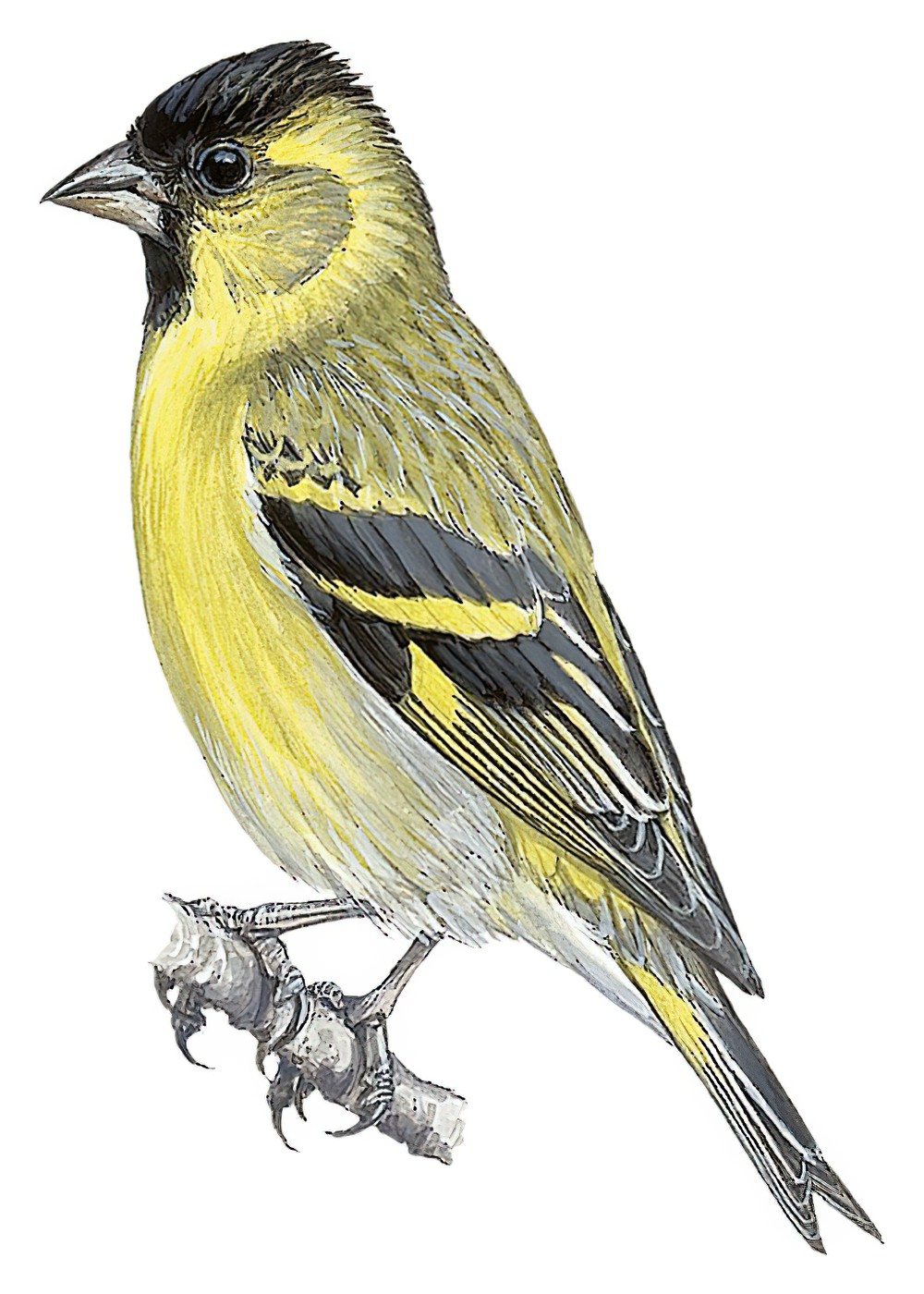Black-chinned Siskin / Spinus barbatus

Black-chinned Siskin
SCI Name:
Protonym: Fringilla barbata SaggioStoriaNat.Chile p.247,345
Taxonomy: Passeriformes / Fringillidae / Spinus
Taxonomy Code: blcsis2
Type Locality: Chile ; restricted to Valparaiso by Todd, 1926, Ann. Carnegie Mus., 17, p. 81.
Author: Molina
Publish Year: 1782
IUCN Status: Least Concern
DEFINITIONS
SPINUS
(Fringillidae; Ϯ Eurasian Siskin S. spinus) Gr. σπινος spinos unidentified bird mentioned by Aristophanes, Dionysius, Hesychius, and others, usually treated as a type of finch < σπιζω spizō to chirp (cf. specific names Fringilla Spinus J. Gmelin, 1789, and Emberiza Spinus von Schrank, 1798); "SYS, in 't Latyn Spinus. Hy is by LINNÆUS. Syst. Nat. [ed. 9, 1756] gesl. 80. oder de Vinken gebracht" (Moehring 1758); "LV. Gattung. Zeisig. Spinus. ... Die Zeisige sind sehr zierliche muntere Vögelchen. ... Ihre Nahrung besteht in kleinen Saamen. Sie nisten auf Bäume. Vier Arten. 146. Distel-Zeisig. Spinus carduelis. ... 147. Lein-Zeisig. Spinus Linaria. ... 148. Citronen-Fink. Spinus Citrinella. ... 149. Erlen-Zeisig. Spinus viridis. ... Fringilla Spinus. Gmel. Linn. S. I. p. 194. n. 25." (Koch 1816); "Spinus Koch, 1816, Syst. Baierischen Zool., Säug. Vögel, 1, p. 232. Type, by tautonymy, Fringilla spinus Linnaeus." (Howell & Paynter in Peters 1968, XIV, 234).
Synon. Acanthilis, Acanthis, Astragalinus, Chrysomitris, Loximitris, Melanomitris, Pseudomitris, Pyrrhomitris, Sporagra.
• (Emberizidae; syn. Emberiza † Corn Bunting E. calandra) "SPINUS Mœhr. (1752). Cynchramus, (Antiq.) Bonap. (1838). Miliaria b, Brehm. (1831). Emberiza, L. S. miliarius, (L.) G. R. Gray. Pl. enl. 233. M. europæa, Swains. ... b Employed in Botany." (G. Gray 1841); "Spinus "Moehr." G. Gray, 1841, List Genera Birds, 2nd ed., p. 61 (not of Koch, 1816). Type, by original designation, S. miliarius (L.), i.e. Emberiza miliaria Linnaeus, 1766 = Emberiza calandra Linnaues, 1758." (JAJ 2021).
spinus
Gr. σπινος spinos unidentified bird mentioned by Aristophanes, Dionysius, Hesychius, and others, usually treated as a type of finch < σπιζω spizō to chirp.
● "98. FRINGILLA. ... Spinus. 19. F. remigibus medio luteis: primis quatuor immaculatis, rectricibus basi flavis apice nigris. Fn. svec. 203. Acanthus avicula. Gesn. av. I. Spinus s. Ligurinus. Aldr. orn. l. 18. c. 4. Will. orn. 192. t. 46. Raj. av. 91. n. 1. Alb. av. 3. p. 71. t. 76. Frisch. av. 2. t. 11. f. 1. 2. Olin. av. 15. Habitat in Europæ juniperetis.” (Linnaeus 1758) (Spinus).
barbatus
L. barbatus bearded < barba beard (see barbata).
● "There are two South-African specimens of a Swift in the Leyden Museum labelled "Cypselus barbatus," which differs from European examples principally in their lighter colour above, particularly on the secondaries and scapulars, in the white feathers of the gular patch presenting a narrow black central line, and in the feathers of the lower back, belly, and under wing-coverts being narrowly margined with white. Two specimens from Natal, collected by Mr. Ayres are similar. It is possible that this form may be entitled to rank as a species, to which Temminck's MS. name may be applied." (P. Sclater 1865) (Apus).
● "DENDRORTYX BARBATUS. Bearded Partridge. ... Head slightly crested, the feathers of which are dark brown; forehead brownish buff; stripe above and behind the eye, throat and sides of the neck leaden grey" (Gould 1846) (Dendrortyx).
● "40. VULTUR. ... barbatus. 5. V. albidus, dorso fusco, jugulo barbato, rostro incarnato, capite linea nigra cincto. Vultur aureus. Gesn. av. 783. t. 781. Vultur barbatus. Edv. av. 106. t. 106. Habitat in Africa. Ad basin maxillæ inferioris barba dependet; frons oculorumque regio atra." (Linnaeus 1758) (Gypaetus). This epithet is the fifth name and first adjectival in avian nomenclature.
● ex “Barbichon de Cayenne” of d’Aubenton 1765-1781, pl. 830, and “Whiskered Fly-catcher” of Latham 1783 (Myiobius).
● ex “Bearded Parrakeet” of Latham 1781 (syn. Psittacula alexandri).
● ex “Merle barbu” of Desfontaines 1789: “Le bec est noir, un peu arqué, long de six à sept lignes; de sa base naissent cinq à six petites soies brunes, roides, de la grosseur d’un crin de cheval” (Pycnonotus).
● ex “Pic à Doubles Moustaches” of Levaillant 1808, pl. 251 (syn. Thripias namaquus).
UPPERCASE: current genus
Uppercase first letter: generic synonym
● and ● See: generic homonyms
lowercase: species and subspecies
●: early names, variants, mispellings
‡: extinct
†: type species
Gr.: ancient Greek
L.: Latin
<: derived from
syn: synonym of
/: separates historical and modern geographic names
ex: based on
TL: type locality
OD: original diagnosis (genus) or original description (species)












